Just a Safari at Baikal.
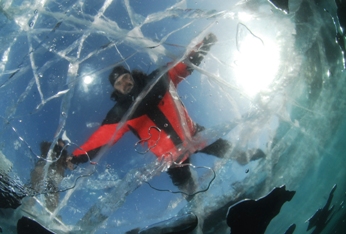
Have you ever been on a diving safari? If so, what are your memories of it? Actually, just a second let me guess: a snow-white dive-boat is going through the waves and all you can see in front is the endless sea. Bright and hot sun is burning the sun-deck, but as soon as you go downstairs you find yourself comforted by the coolness of the rocking boat. It is easy to enjoy a great company and the beauty of a dive-site after dive-site as your journey is coming to an end. Most likely the description above could be a pamphlet for an essay called “How I spent my time in a safari”. Now let’s imagine the same but with minor “nuances”. A really green UAZ is crawling across the Baikal ice, its engine and transmission are rumbling. Outside harsh Barguzin wind is blowing. Inside a not so quiet UAZ people, equipment and bags are moving around after every bump, and the cabin is kept warm thanks to everybody’s breathing and the heater. This trip already can hardly be called boring, and together with Baikal under-ice diving it becomes all about fun. These were the pictures that came to our mind when our friends from dive center “BaikalTek” have invited us to an ice safari at Baikal. Obviously enough it was not hard to convince us to join in, our packing was short and we were anxious to get away from the chaos of March holidays.
It takes only about 30 hours to get from Novosibirsk to Irkutsk by train. Those hours we spent sleeping, reading old newspapers and perfecting our team communication at the dinner table. We have to say that we believe that the time machine has already been invented by our railway system. Unfortunately they are still unable to get you into the future, but into the past…Last time I was on the train was about 15 years ago and nothing, absolutely nothing has changed: the same beat of wheels, clinging of the spoon in the glass, and even the neighbor, who is still wearing sweat pants and slippers on bare feet, asks the same question: “Could your bags be any bigger?!”.
Irkutsk greeted us with dry pavements, wide white-teeth smiles of our hosts and a complete lack of “Beeline” (Russian phone carrier). We load our staff into Mercedes provided by “BaikalTek” and we’re on our way. Ice is still about 320 km away, but pleasant surprises await us along the way. We have tried 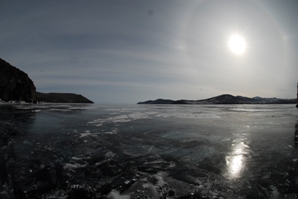 Buryat pozy (ravioli type dish), chased them with vodka and stopped at the rest stops, where huts all covered with ribbons according to Buryat tradition.
Buryat pozy (ravioli type dish), chased them with vodka and stopped at the rest stops, where huts all covered with ribbons according to Buryat tradition.
We have finally reached the ice crossing. The Olkhon Island seems so close, but the actual distance to it is quite significant, both by ice and by water. It takes half-an-hour on “Sang Yang” to get there. In summer the connection between Olkhon and main land is done with the help of ferry terminal. Locals say that car lines reach kilometers and last for days; and if somebody tries to cut in the line starts to resemble a battle field. Thankfully, that wouldn’t be a problem for us. All we can see is a plain that is smoother and stronger than any pavement. As soon as we drive on to the ice we have to make a stop. It is a tradition to charm Burkhan, the spirit of the lake. What do you use to do that? Take a lucky guess.
During our ride we were able to get a crash course into the geography and history of Olkhon. Once nationally famous fish plant has been closed ever since Soviet Union collapsedand central power was established here only a couple of years ago. There is absolutely no snow on the island, but plenty of sand instead – we’re told that the settlings on the north of the island get completely covered with sand dunes. We double check where we’re staying on the island…
Farmstead of Nikita Bencharov resembles an oasis or; it became our shelter for the entire safari. It reminds of an oasis because it has everything what the rest of the island doesn’t have: starting with European outlets and ending with, pardon me, biotoilets. It also reminds of a fortress. A fortress, where behind a massive fence, friendliness and comfort are the main characteristics. In reality it is an eclectic yard with wooden houses.
For those who still had energy our hosts organized a mini-trip to the small isles around Olkhon. This is how we got a bunch of pictures of a lonely UAZ with never ending white ice in the background, along with a similarly lonely Buddhist sculpture all covered with colorful ribbons and knots. To top of our first day impressions we became witnesses to a golden sunset.
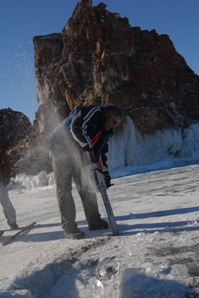 Do you know that Olkhon has over 300 sunny days a year? Even Krym cannot compete with that! We realized it the next morning before heading to the dive-site. Trust me such a bright orange sun can be both a treasure and a danger for a very white-faced Siberian.
Do you know that Olkhon has over 300 sunny days a year? Even Krym cannot compete with that! We realized it the next morning before heading to the dive-site. Trust me such a bright orange sun can be both a treasure and a danger for a very white-faced Siberian.
Our first dive site is a famous cape Burkhan and mountain Shamanka. Without exaggeration, these are places of worship for… almost wrote – divers. By the way, possibly it’s true, considering that diving here has just started up recently. Anyhow, it is a place of worship for Shamanists and Buddhists – and it took so long for divers to get people used to them, before they were arrogant enough (or maybe stupid) to make the first dive here. I am not positive what sort of spirits live here, but they’re definitely not indifferent to the compass arrow – poor thing keeps on going in going in circles like a merry-go-round, without even pausing for a second. Next we concentrate on making maina (diving-hole in the ice) following the pre-made by the electric-saw contour.
Baikal Ice. Nine of ten of our praises would go to it. In last eight years we had an opportunity to see a wide variety of ice. We have seen ice that was more powerful that Baikal’s, just as clear and also covered with the web of cracks…however we have never seen an ice quite like Baikal ice! And if we were to create a rating for all the ices we’ve seen, Baikal ice would be leading by far. It has something eye-catching – sort of like a flame or a waterfall - you just can’t stop looking at it. It has an enormous energy: just imagine that this meter-thick substance is born within a month. Often there is no ice on Baikal in January, but in mid-March the ice often already starts moving and breaking. The color of the ice varies from deep-blue to emerald green, depending on place, time, light and probably 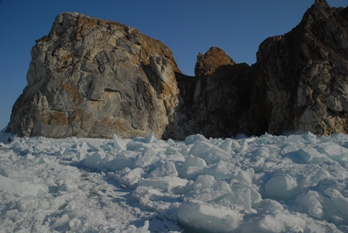 Baikal’s mood.
Baikal’s mood.
The cracks in the ice deserve a separate article. Some of them go all the way through entire thickness of the ice – these are the result of considerable movements. Most likely in places like that ice will eventually move apart and leave open water. Or two planes of ice will move onto one another, break each other and create mountains of broken ice (commonly called in Russian “toros”). Another scenario is that one plane of ice will “duck” under the other and sink. We can proudly say that during our trip we have seen all sorts of ice movements and their outcomes. The most lasting impression was left by this one “little” crack, which was about twenty meters wide and the length of it reached the horizon. We’re lucky we weren’t there when this crack was born. The next wonder we’ve seen was a field of toroses. Creation of the elements! The ice was formed, and then it started moving, then froze again and moved again and froze one more time, this time forming a toros field – and so on over and over again! As a result there is an ice battlefield, where numerous pieces of ice are as high as two meters, along with tiny bits of ice scattered all over the place. The strength of ice is also impressive. This is proven to us when we are trying to create maina with an ice pick and it seemed like we’re working with a toothpick.
The web-cracks are also unbelievable! All of them are quite deep – about ten to fifteen centimeters wide. It looks like an artist was trying to create a geometrical drawing, changing each time the  direction, the depth and the step of the web. I don’t understand how it was possible to create this without ruining the clarity of the ice… but maybe it’s not necessary to understand this – simply enjoy the beauty!
direction, the depth and the step of the web. I don’t understand how it was possible to create this without ruining the clarity of the ice… but maybe it’s not necessary to understand this – simply enjoy the beauty!
The water barely reaches half of a degree and it seems much thicker than the usual water. It looks like two elements – water and ice - become one. The only way you can see the borders of ice and water is by looking at the bubbles created by a fellow diver. Underwater is a stone greatness. Nearby almost perfectly shaped stones you feel like a midget. On the bottom bychki (Baikal fish) are sunbathing, small shells are scattered and the sand shines with gold and silver from various minerals. Transparency… we wish we had a half of it in Siberia! Compass shows anything you wish except the north direction, and the closer you get to Shamanka the faster the arrow goes around in any direction. We dive a couple of times, going out of the water only to switch tanks or to eat some grilled Baikal omul (another local fish). After diving we’re ready for the next item of the entertainment program – Russian banya (Russian sauna). Where did banya come from one might ask? Well, it stands on skis and is dragged behind the UAZ as a trailer – ingenious invention! For the time of banya-procedures, our maina becomes a hole for heated bodies to jump in with a hiss. Life is beautiful!
Next morning greets us with even brighter sun and warm wind from the shore; we pack and head towards cape Hoboi. It is at the northern point of the Olkhon Island, in about two kilometers from which is the deepest point of the lake – about 1,637 meters. The pictures on the internet show this place framed with cliffs going all the way from the abyss of the lake up to the sky, the waves crashing and foaming around them. We haven’t found any winter pictures of this place on the internet – so a camera is a must!
The cape is about 40 kilometers away. We’re not sure what is ice like along Maloe More, so we decide to drive as far as possible on land, and then turn on to the ice at the last moment. The further north you go the less signs of human presence you see. We lose our cell phone reception, then the road is purely notional, then there is an abandoned airfield…. All around us is sand and sand dunes. Those are absolutely regular dunes, which move with the wind and cover everything on their way. Ahead, beyond the pines, we see a huge sand cone; it’s time to turn on to ice.
At first we’re able to drive on ice at a regular “pavement” speed, then ice becomes scruffier, and the bumps become more noticeable. Hoboi is already visible. While one of the UAZs is driving ahead to check the road, we get out to stretch and look around at ice caves and toroses. By now we’ve seen plenty of toroses; however caves with stalactites and stalagmites are a novelty. Judging by the ice-floor all of them have a significant underwater part. Some of the stalactites reach about a meter in length and we are tempted to put on a hard hat and other protective gear. Our UAZ is back and the verdict is: there is a road. We naively ask: “Is it possible that there is none?” “Easily” - we get an answer: “Yesterday we’ve reached that crack other there. Stopped, smoked and left. Baikal!”
Hoboi strikes with the magnificence of steep cliffs. They say that there is an energy outlet here – “there it is, marked with blue paint on the cliff…”We create two mainas accompanied by the sounds of thick breaking ice, the cracks barely part, marking their existence by the out flowing water. Guys from  “BaikalTek” tell us that a year ago they got a two-meter crack only three meters away from the car. We look around, to assess our chances.
“BaikalTek” tell us that a year ago they got a two-meter crack only three meters away from the car. We look around, to assess our chances.
Underwater there is a steep wall covered with sponge. But this is not what’s important. Ice is what was worth a drive! If you imagine that ice “toroses” on the surface are sharp mountains, then the same “toroses” underwater are steep hills with broad valleys. If above you can decipher all the details of this “mountains, then underwater they all appear smooth and polished by invisible hand with gentle and sleek lines. The forms are really amazing. This one looks like a bagel, why and how was this form created is unknown; one can only shrug shoulders – new underwater sign for divers. Also there is a couple of “hills” that remind of the camel humps, they almost connect to each other in the peaks forming half-a-cave and half-a-tunnel. The only inconvenience is to navigate in between the “hills” – safety rope constantly catches on various parts of the ice constructions. The bottom is a habitat of the sponge, it almost reminds of jungles. Some “trees” are higher than a meter. Frankly, nobody was interested in these plants at first, until somebody discovered that they grow 1 centimeter per year. So this one-meter “tree” is 100 years old! It deserves, at minimum, respect…
We’re looking around and we notice a dark shadow above us…. It’s our dear old UAZ! Here are the wheels, the exhaust….Next to the “maina” is a working atmosphere, it is hard to tell who is who though – we can only judge by the show size! J
We get out on the surface. And the sky gets covered with dark-blue clouds; there is not even a ray of sunshine. Cold wind almost hurts and wet equipment gets immediately covered with ice. Some brave ones are fast enough to take of a scuba; the others take off only the mask and gloves. As usual, UAZ with its super-heater comes to our rescue. We apologize to the drivers and melt right in the cars, covering the floor with a layer of water. Unfortunately, we might not be able to do the second dive… We’re warming up. Shouting above the wind hosts invite us to the lunch table, hidden behind the green body of UAZ. We lazily get out of the wet cars and walk to the dining table – hunger is powerful, especially after a dive. Warm food and drinks, together with chit-chat about the impressions from a dive, warm up our bodies and souls, and in the end completely improve our mood that was brought down by the weather. Like in the movie with fast changing scenes, the clouds suddenly go away; sun comes out in the middle of the sky and starts shining all other cape Hoboi with warm spring rays…. “Should we go for a second dive?” – We ask one another. “What’s the question???Of course! Done deal!”
The road back is as usual shorter, accompanied by the fantastic views of Baikal’s sunset. Sunset is truly beautiful here. Even our driver, who drives such…strange people, like us not for the first time, stopped, got out and suggested: “Fellas, let’s stand and look – what a beauty!” Fellas obviously didn’t mind.
The ultimate point of our safari is strait Olkhon Gates where summer ferry and winter ice crossing are organized. This is a very logical place for another dive, by the way. See for yourself, Hoboi is on the n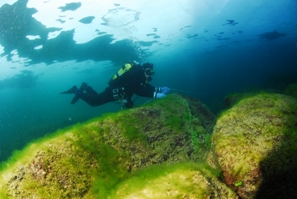 orth, Khuzir and surroundings are in the center and Olkhon Gates are on the south. This completes the circle, so to say. Besides, if there is a desire to assess the prospects – there is no better place. No, not the prospects of diving at Olkhon (this, in my opinion, is all clear); but the prospects of Lake Baikal, its broad space. It’s not just a line of ice, rolling in the sky line, but a line that is beautifully completed with the other islands and islets - perfect place! There is no other place with such transparent and beautiful ice. Standing on its surface and looking down through it on several dozens of water, you can still count the number of pebbles on the bottom. And if you would want to go ice-fishing here in between dives, you wouldn’t need any floats to mark that the fish is caught – you could see everything like through a glass.
orth, Khuzir and surroundings are in the center and Olkhon Gates are on the south. This completes the circle, so to say. Besides, if there is a desire to assess the prospects – there is no better place. No, not the prospects of diving at Olkhon (this, in my opinion, is all clear); but the prospects of Lake Baikal, its broad space. It’s not just a line of ice, rolling in the sky line, but a line that is beautifully completed with the other islands and islets - perfect place! There is no other place with such transparent and beautiful ice. Standing on its surface and looking down through it on several dozens of water, you can still count the number of pebbles on the bottom. And if you would want to go ice-fishing here in between dives, you wouldn’t need any floats to mark that the fish is caught – you could see everything like through a glass.
The horizontal transparency is more than 30 meters; the lightning is the same as on the surface. For the first time “Halzion” is not necessary and it is left inside the cabin. Among the sponge plants bychki are resting – this almost reminds of Red sea, except the colors are more modest. In the stones next to the shore a couple of whitefishes are snooping around, or maybe those are omuls, I still haven’t figured out how to tell them apart. Everything is favorable for a relaxing dive that would finish off our safari. 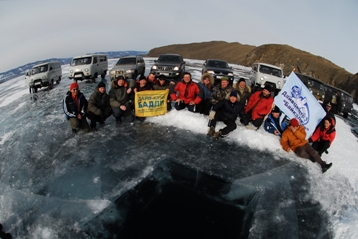 As our guides tell us, in summer it’s not as calm here – the current is rather strong and this makes the water not as clear. This is the beauty of under-ice diving: you get practically on hard surface, without rocking in the boat, anywhere and dive – almost in greenhouse conditions. Actually, that’s what we’ve been doing these days.
As our guides tell us, in summer it’s not as calm here – the current is rather strong and this makes the water not as clear. This is the beauty of under-ice diving: you get practically on hard surface, without rocking in the boat, anywhere and dive – almost in greenhouse conditions. Actually, that’s what we’ve been doing these days.
At the finish line we take a group photo, thank each other, hug each other and as usual promise to be back and dive more. On the night train we’re dreaming about Baikal ice and steep cliffs – the time machine is working perfectly, bringing us back to the recent past.
Autor: Oleg Bocharnikov MSDT #626997 Magazine "Asian Geographic" №2 2009